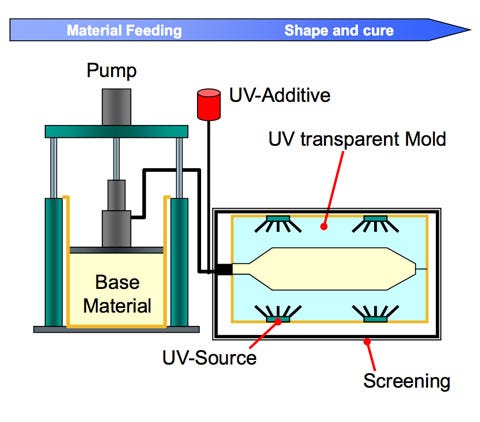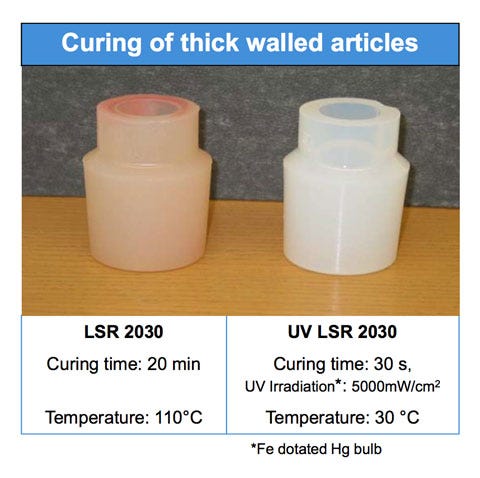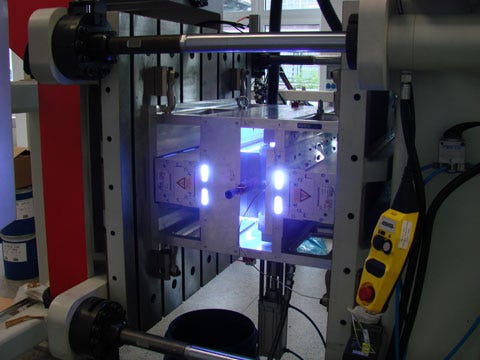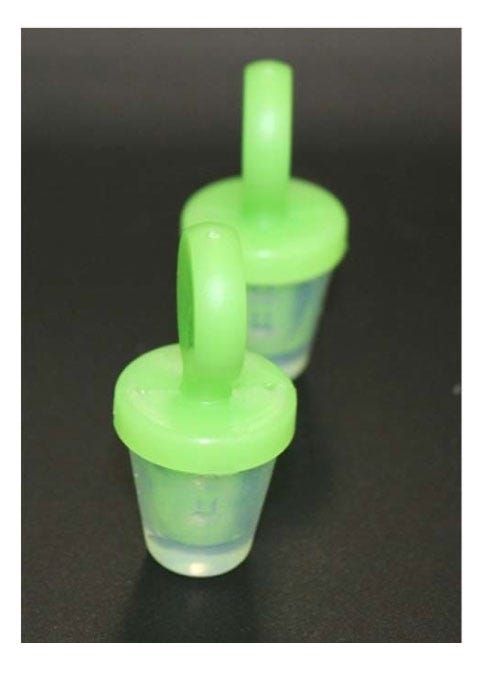UV-Curing Silicone Rubbers Enable New Medical Concepts and Part Designs
UV-curing liquid silicone rubbers cure quickly at low temperatures, opening the door for new two-component combinations of silicones and polyolefins.
June 18, 2013
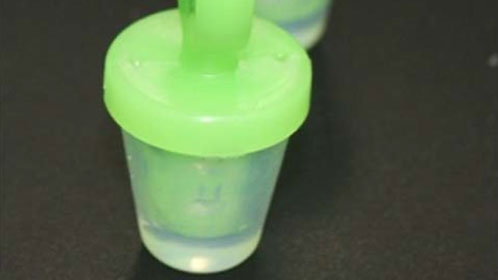
Silicone elastomers have many properties that make them well suited for applications in the healthcare industry. These materials feature biocompatibility, strong heat aging properties, high chemical resistance, ultraviolet (UV) stability, low compression set, purity, clarity, ease of processing, and stable mechanical properties at a temperature range from –40°C to 200°C.
|
Figure 1. This figure depicts UV curing of LSR. |
Typically, liquid silicone rubber (LSR) is cured by a platinum-catalyzed hydrosilation reaction, but Momentive Performance Materials has developed a new family of silicone rubbers can be cured by UV light where the crosslinking is initiated by a photochemical reaction rather than heat. This technology enables parts to be cured quickly and at low temperatures. It also allows silicone rubbers to be combined with many temperature-sensitive materials.
Like heat-curing LSRs, UV-curing LSR is based on an addition cure mechanism. The major difference is that UV-curing LSR contains a photosensitive catalyst. The UV-cured silicone elastomer typically retains the same properties and benefits of thermally cured silicone elastomers.
UV-curing LSRs can be processed with injection molding machines using special molds. Without the need for long curing times during heating, this technology can result in energy savings. For processing in cleanroom environments, it can be advantageous to work with low temperatures, as heating up and cooling down tends to consume considerable time and energy in such an environment.
Comparison of Curing Behavior of UV LSR
|
Figure 2. A comparison revelas the differences between heat-cured and UV-cured LSR. |
UV-curing LSR typically cures quickly at ambient or slightly elevated temperatures (25–40°C). Thicker parts, in particular, may vulcanize much more quickly with the UV-curing technology than with thermal curing technology because the low thermal conductivity of the silicone rubber is no longer a limiting factor. Another advantage of UV curing is the fact that the crosslinking reaction begins when the light is switched on rather than when the liquid rubber has been injected into the hot mold, virtually eliminating the issue of silicone rubber scorching.
Processing of UV-Curing Liquid Silicone Rubbers
Standard liquid silicone rubbers are processed in an injection molding process generally at temperatures between 180 and 200°C. UV-curing LSR parts are also manufactured in an injection molding process but with transparent molds cured by UV light as shown in Figure 1. The mixing of UV base material and the UV catalyst through a static mixer followed by injection into the special mold is comparable to standard LSR processing. The main difference is the mixing ratio (100:2 instead of 1:1). The injection molding machines used for the thermal-curing LSRs may also be used for the UV-curing products by simply changing the mold and integrating a UV source.
The lower temperature in the mold may enable the production of higher quality parts because there is typically less shrinkage, no air entrapment, and controlled scorch performance. Even cross sections up to 100 mm typically cure in less than five minutes, as compared with more than 30 minutes in a conventional heat-curing process. Figure 2 shows a silicone elastomer plug where the curing time was reduced from 20 minutes to 30 seconds.
|
Figure 3.UV LSR molding during UV curing. |
The UV irradiation can be generated by gas discharge lamps (microwave or electrode system), which are well known in the printing industry, for example. Microwave systems are larger because the microwave generator is directly connected to the lamp, so electrode systems are generally preferred for the molding process. The lamp must be incorporated into the machine, and the generator for the electrode lamp can stay outside the mold and injection molding machine. Figure 3 shows an example of UV LSR molding during the UV irradiation. The electrode lamps produce a high-voltage arc between two electrodes that leads to the vaporization of mercury and possible dotations (Iron: D-bulb or Gallium: V-bulb). The wavelengths of those lamps are 200–400 nm. The catalyst needs UVA irradiation in the wavelength of 320–400 nm.
Another way to cure UV-curing LSRs is by using LED lamps that emit wavelengths centered around 365 nm and with an output of more than 4000 mW/cm2. LED lamps are small and can be easily integrated into the injection molding process. A minimum UVA dosage of 5 J/cm2 is generally needed to ensure efficient activation of the curing system.
Mold Requirements for UV-Curing LSR
|
Figure 4. Mold concept of a two-component UV LSR molding. |
The material used for the mold has to be UV transparent as well as UV stable, which is one of the challenges of the UV-curing process. Only quartz glass and special polymethyl methacrylate (PMMA) currently offer this combination. For most projects, a special acrylic polymer mold is used due to its ease of handling, higher freedom of design and less brittleness as compared with quartz glass. PMMA has a heat stability of up to 70°C, which generally is sufficient for the UV-curing injection molding process.
Because gas evaporation lamps generate a significant amount of infrared (IR) irradiation, the mold design requires cooling channels to avoid a deformation of the PMMA. LED lamps emit a small amount of IR, so cooling is generally not necessary. The lifetime of acrylic molds is typically significantly longer when LED technology is used because of the accurate wavelength spectrum and the low amount of IR.
Two-Component Injection Molding with UV-Curing LSRs
With curing temperatures of only 30–40 °C, UV-curing technology can enable new two-component combinations of silicones with polyolefins such as polyethylene (PE) and polypropylene (PP) or other standard thermoplastics. Two-component injection molding is used for a variety of silicone elastomer and plastic parts in the healthcare industry, including face masks and valves. However, to achieve short and efficient cycle times with standard LSRs, the mold must be heated to at least 120°C. Therefore, two-component applications are often limited to temperature-stable polymers such as nylon and polyesters because of the high temperatures in the injection molding process.
Figure 4 shows an example of a mold concept for a two-component UV-curing LSR molding. The PMMA insert was built on one side of the cavity. The injected UV-curing LSR was then cured by an integrated UV light LED system in 20 seconds. The mold temperature still had an impact on the process. For stable and optimum curing with good demolding properties, it is recommended to set tool temperatures in the range of 30–40°C. The cavity pressure did not rise significantly as temperature rises only moderately during the thermal expansion. In contrast, in the standard heat-cure LSR process a significant cavity pressure is built due to the mold temperatures rising above 120°C. The expected pressure inside the cavity is <50 bar.
Potential Applications in the Medical Industry
Two-component products that require a combination of silicone with plastic, such as face masks, valves, closures, grips for surgical and dental instruments, and teething rings for infant care could benefit from this new technology.1 UV-curing LSR could also enable an electronic device to be embedded into a silicone elastomer.
|
These molded wine plugs are made from PP and UV LSR. |
The UV-cured elastomers have passed regulatory compliance tests including ISO 10993, USP Class VI, extraction limits according to 21 CFR 77.2600, enabling these elastomeric parts to be considered for use in healthcare applications. UV-curing LSRs could be particularly advantageous in the medical device industry, where the ability to cure at low temperatures can enable product innovation in combination with other plastics or thermally sensitive ingredients.
Summary and Outlook
UV-curing technology opens up new potential application fields for LSRs because the process can enable fast curing at low temperatures while maintaining the superior properties of a conventional silicone elastomer. This can be particularly advantageous in the medical device industry, where the ability to cure at low temperatures may open doors for product innovations that were previously impossible in temperature-sensitive parts.
References
1. Doug Smock, “Unique Mold, Materials Speed LSR Two-Component Molding,” in Plastics Today [online] (Santa Monica, CA: UBM Canon, 2012); available from Internet: www.plasticstoday.com/articles/unique-mold-materials-speed-lsr-2-component-molding0709201201.
Beate Ganter is the senior project manager for UV curing silicone rubbers at Momentive Performance Materials Inc. (MPM; Leverkusen, Germany). Her career in product development and marketing spans more than a decade. Before joining MPM in 2007, Ganter worked with Bayer AG, later GE Bayer Silicones, in the development of silicone rubber. She earned her bachelor’s degree in chemistry and her Ph.D. in metal organic chemistry from the Technical University of Aachen in Germany.Reach her at [email protected].
You May Also Like
